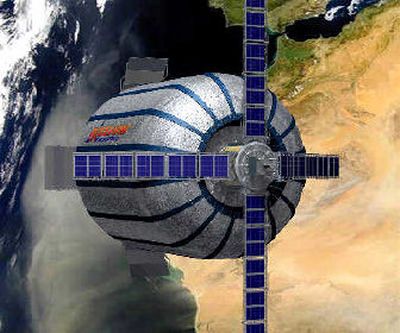New space technology will launch today

LOS ANGELES — A hotel tycoon’s dream of building an inflatable commercial space station is taking a step toward reality — or a reality check — with the launch of a satellite that will test the technology behind the orbital outpost.
The fact-finding mission scheduled for this week will explore the feasibility of Robert Bigelow’s planned commercial space complex. When finished by 2015, he said, it will consist of balloon-like modules strung together like sausage links and serve as a hotel, laboratory, college or entertainment venue.
The planned liftoff from Russia of Bigelow Aerospace’s privately funded Genesis I spacecraft will mark the beginning of the startup’s attempt to break into the fledging manned commercial spaceflight business.
Bigelow, who made his fortune with the Las Vegas-based Budget Suites of America hotel chain, has remained mum about the exact launch date of the prototype. But the Russian space agency Roskosmos posted on its Web site that Genesis was scheduled to launch today aboard a converted Cold War ballistic missile from the Dombarovsky missile base in the southern Ural Mountains.
Bigelow said Tuesday he was bracing for the possibility of failure on the spacecraft’s on-board systems because of the experimental nature of the flight.
“I wouldn’t be the least bit surprised if we have a number of different systems fail,” he said in a telephone interview with The Associated Press from his Las Vegas headquarters. “I would hope that we have some success.”
The company plans to boost several prototypes into orbit this decade to increase the chances of success. Subsequent launches will test docking among spacecraft. But the maiden Genesis flight will primarily test the inflation process.
The watermelon-shaped Genesis I is a one-third scale model of a commercial space station to which the company eventually hopes to fly humans. It is outfitted with 13 interior and exterior cameras to shoot video and photos of the Earth.
Unlike the rigid aluminum modules that make up the international space station, the inflatable design consists of a flexible outer shell that can be expanded in space. The module is padded with layers made of tough materials including Kevlar, the stuff of police vests, to withstand cosmic debris.
Inflatable technology isn’t new. NASA researched the concept in the 1990s for a potential trip to Mars, but later abandoned it after determining that the huge pop-proof balloons were too costly. Bigelow Aerospace essentially picked up the project.
The 2,800-pound Genesis I is about 14 feet long and about 4 feet wide at launch. Its payload includes personal effects from Bigelow employees and dozens of insects and cockroaches to see how well they survive in the spacecraft.
Once in orbit 340 miles above Earth, Genesis I will expand to twice its pre-inflated width and circle the Earth for at least five years while scientists collect information about its durability and other capabilities.
“We know very, very little about the actual engineering and performance of these systems. As a matter of fact, we really know nothing,” Bigelow corporate counsel Mike Gold said earlier this year.